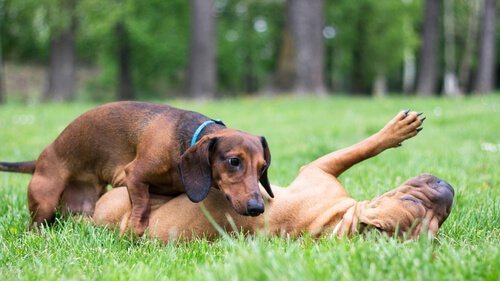How to Care for a Dog That Is in Heat

What Does It Mean To “Be in Heat”?
During this period, the dog will secrete more hormones than usual and may behave strangely. This is normal and is no cause for alarm. On the other hand, if the behavior continues, then it may be time to do something.
Remember that your dog will have a period where she will bleed constantly from the genital area. For that reason, as well as many others, you have to be prepared to deal with it all properly.
How Long Does Is a Dog in Heat?
The reproductive cycle of dogs lasts an average of 20 days, depending on the individual (like in humans). There are two phases or stages.
- The first stage is the most visible. This is when the dog begins to bleed and behave strangely. You may notice changes and swelling in the vulva due to the bleeding, which sometimes lasts up to 10 days.

Ideally, you would let your dog go through the process naturally, but if practicality is your priority, you can use special pants for dogs that have a sanitary pad. Change it every so often to prevent unwanted stains in your home.
Once the bleeding stage ends, the phase begins in which the dog starts getting more attention from the males. Pay close attention whenever you plan on taking a dog that is in heat out on a walk.
This doesn’t mean you need to keep your dog locked up in your house. You don’t need to isolate her from the outside world; just be more conscious of your dog’s safety. Dogs, like many other animals, follow the female’s pheromones, so don’t be surprised if you see dogs barking at your door.
Walking your Dog That Is in Heat
This stage lasts sometimes 10 days long, in some cases 20 days, so leaving your dog home alone isn’t a practical or good option. But don’t worry. Letting her out is the best thing for her and for you. Here are tips on how to take your female dog that is in heat out on walks:
- Take someone else on the walk with you. Aside from being a welcome change of pace, they can help you keep away undesired males wanting to mate with your female.
- Dress your dog in a pair of pants. If you can’t keep the male from mounting your female, the pants will get impede them. They may be a bit embarrassing for your dog to wear, but it’s either that or an unwanted pregnancy, right?
- Go for a walk at a different time of day. If you tend to run into a lot of dogs at your usual walk time, try going at another time of day.

Is a Dog That Is in Heat Less Healthy?
It’s true that animal sterilization provides many different health benefits for your dog, but that doesn’t mean it’s obligatory. A non-sterilized female can lead a completely normal life, as long as she has not mated.
If she dog has mated, her risk of disease increases considerably. Cancer of their genitals and breasts are two of the most common ones.
If you want to breed a female, don’t do it during the first two times she’s in heat. In fact, it’s best to wait until she’s at least two years old. The mortality rate of both mother and puppies goes down considerably then.
The good thing about sterilization is that you can do it at any age. However, it is highly recommended for it to be performed after the first time your female goes into heat, so that her body has a chance to develop normally.
In short, we can argue that a sterilized female dog has a higher quality of life in contrast to one that is not. Remember: if your dog is in heat, it’s normal. You’ll just need to take care of her a little more.